I have put this topic under ‘Guide to Buying Diamonds & Jewelry’, for buyers that are curious to know what happens behind the scene in a gemological laboratory. Diamond and jewelry buyers can also learn about the commonly used tools by jewelers and dealers.
Please do not confuse gemmological instruments with tools and accessories used in gemmology and by jewelry traders/dealers.

List of some commonly used instruments in gemology
1) Loupes (Hand Lens)
2) Spectroscope
3) Refractometer
4) Dichroscope
5) Chelsea color filter
6) Polarascope
7) Microscope
8) Ultraviolet Lamp
9) Heavy Liquids
10) Hardness Pencils
11) Weighing Scales
12) Electronic Diamond Tester
13) Dark Feild Loupe
14) Gemstone Gauges
15) Day Light Lamp
16) Miscellaneous
Loupes, Spectroscopes and Refractometers are covered on this page (Part 1). Click here to go to Part II
1) Loupes.
Loupes also known as jewelers loupe or eye loupe is a compact hand lens (Convex lens). It is the most basic instrument for evaluating gemstones. The recommended and standard magnification for a jewelers loop is 10X magnification. It is also portable and can be used either in the feild or in the laboratory.
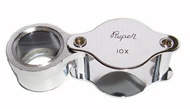
Ruper/Viking Hand Lens 10X
10X and 20X Hand Lens
With the help of a jewelers loupe one can identify inclusions and imperfections in a gemstone. It can also be used to evaluate the quality of faceting of a gemstone.
Different sizes and quality of Eye Loupes are available in the market.
Some common sizes of loupes: Diameter of 17mm, 18mm and 21mm.
Some common types of eye loupes are:
i) Hexagonal shape big eye loupe which comes in chrome or black total matt finish.
ii) Big oval shape
iii) Small hexagonal shape
iv) Economy loupe- Made of plastic lens.
The 10X loupe is also the standard magnification used for grading the clarity of diamonds.
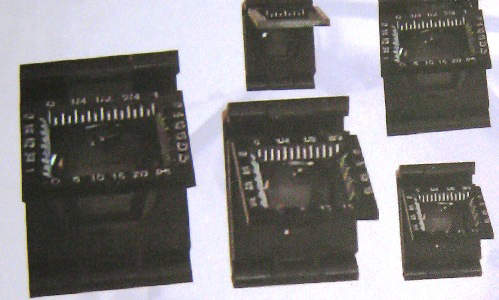
Hexagoal shaped big jewelers loupe.
The correct procedure for using a jewelers loupe:
i) The stoned should be cleaned thoroughly.
ii)The lens should be held very close to your eye, the hand holding the lens must be steadied against your cheek or nose.
iii)The stone should be held with your hand or preferably with a tweezer about one inch from the lens.
iv) The stone should be observed with light coming from the side, the stone should always be in the light while the lens should be out of light.
v) Look at the surface characteristics (eg pits, polishing lines) of the gemstones first, then focus on the inclusions.
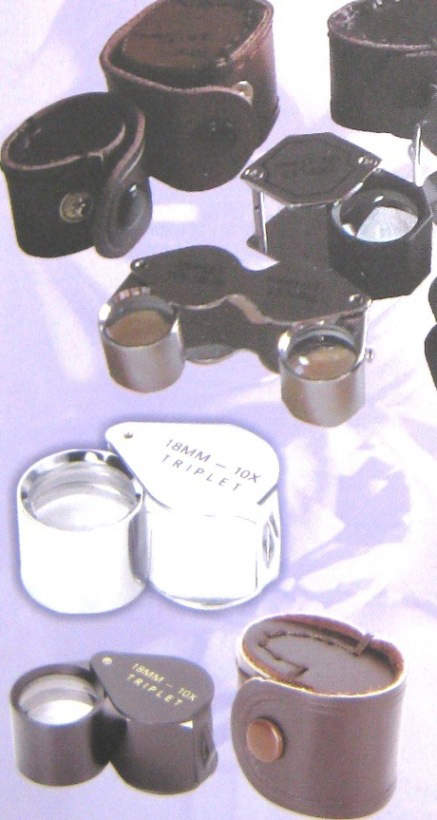
Jewelers loupes and case
The hand lens can give some basic information on the external and internal condition of the gemstone. Some of the external conditions that can be detected are surface cracks and flaws, surface chips, scratches, polishing standard (eg polishing marks), worn facet edges and quality of cutting. The internal features of the gemstone that can be detected using a jewelers loop include characteristic inclusions of natural or synthetic gemstones, internal cracks and flaws and uniformity of the color of the gemstone (eg color banding).
A good quality loupe must correct for aberrations- Defects of the lens. Two different types of aberrations that must be corrected are chromatic aberration and spherical aberration:
i) Chromatic Aberration:
This is the color distortion due to the material the lens is made up of. Color fringes are produced around an image due to the optical dispersion of the glass used to make the lens.
Chromatic aberration can be corrected by manufacturing the lens in two different sections, each having a different dispersion. One of the lenses is bi-convex and the other is bi-concave.These composte lenses that do not have chromatic aberration are known as achromatic lenses.
ii) Spherical Aberration:
Occurs due to the curvature (shape) of the lens. This results in focusing of the rays that pass through the edges of the lens to a point closer to the lens than the focal point. The resulting image will have a hazy and distorted circumference. This can be corrected by replacing the single lens with lenses of different radii (different curvatures).

Tripods with convex (Magnifying lenses). Usually comes in 10X and 6X magnification. Tripods can be used just like jewelers loupe (Hand lens).
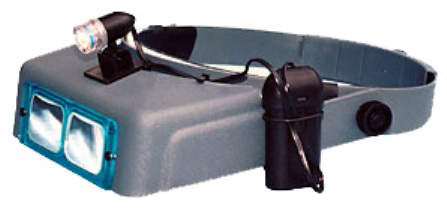
Optivisor by Donegan USA with xenon light, usually comes with lens magnification from 2.5X to 3.5X.
2) Spectroscope:
A spectroscope is an instrument that splits light into its component colors after it passes through the material that is to be tested. The visible spectrum ranges from 4000Å to 7000Å. If the gemstone absorbs certain type of light, it will reveal a characteristic appearance. The wavelengths that are absorbed by the stone are seen in the spectroscope as vertical black lines in the spectrum.
There are two types of spectroscopes:
i) Diffraction Grating Spectroscope: This spectroscope is based on the principle of diffraction. Here light is diffracted by a thin film of diffraction grating material after it enters through a narrow slit.
The small portable diffraction spectroscope is the most commonly used spectroscope in the gem and jewellery trade.

Small portable diffraction spectroscope, made by OPL- Orwin Products Ltd UK.
The OPL diffraction spectroscope is probably the most popular brand available.
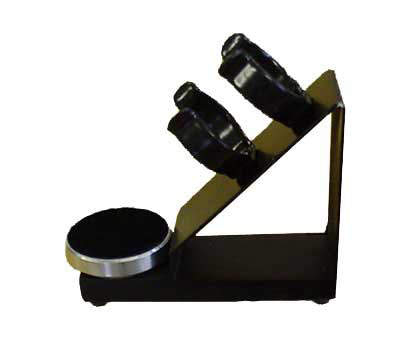
Stand for the OPL Spectroscope, manufactured by OPL
Diffraction spectroscopes have more red than in standard prism spectroscopes and do not have built in scale.
The portable spectroscopes are made up of a metal tube of length about 3 to 6 cm. A high intensity light source such as a powerful pen torch or fiber optic light is needed to use the instrument. Both rough and cut gemstones can be examined using a spectroscope.
The spectroscope is one of the few instruments that can be used to test gemstones deeply set in jewellery.

OPL Students spectra reference sheet.
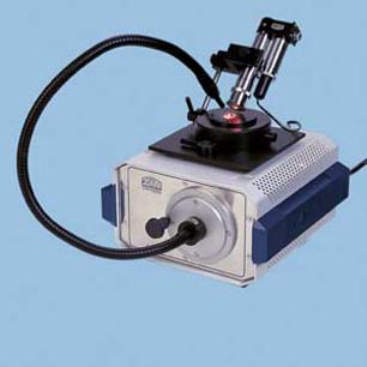
Gemstone spectroscope by Kruss with fiber optic light
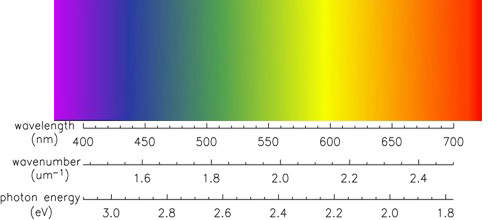
Diffraction grating spectrum with scale in nano meters (nm). Note that here the red is on the right side. Most reference sheets on absorption spectrum will give the red on the left (US System).
ii) Prism Spectroscope: is based on the principle of dispersion of light. Here light enters through a narrow slit and is dispersed through a series of prisms. Some models also have a built in scale.
In prism spectroscopes the blue area is more spread out than in diffraction spectroscopes. The red areas are also more condensed than in the diffraction spectroscopes.
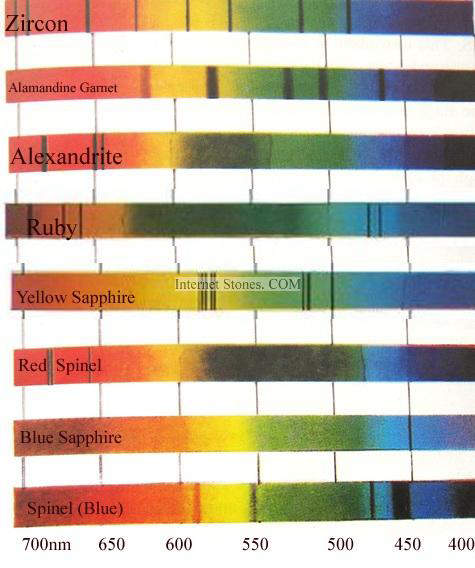
The Absorption Bands/ Spectra of Some Gemstones taken by using a spectroscope
Modern laboratory spectrographs use CCD electronic detectors instead of photographic paper.
Table of the components of light spectrum
| Color | Nanometers (nm) |
| Ultra-violet | 100-390 |
| Violet | 390-430 |
| Blue | 430-490 |
| Blue-Green | 490-510 |
| Green | 510-550 |
| Yellow-Green | 550-575 |
| yellow | 575-590 |
| Orange | 590-630 |
| Orange-Red | 630-650 |
| Red | 650-700 |
| Deep-Red | 700-780 |
| Infra-Red | 780-1000,000 |
How to Use a Spectroscope
The first step in using a spectroscope is to confirm that you have a good light source to use the spectroscope. To do this simply look through the spectroscope at the light source alone, if it has any vertical lines it is not a good light source.
There are two main techniques that can be used in spectroscopy, the transmitted light technique and the reflected light technique.

The correct position for using a spectroscope
The reflected light technique (illustrated in the above diagram) will be discussed in detail as it is the most widely used technique. In this technique the gemstone is placed upside down (on its table) on a black non-reflective surface.
Light should enter the pavilion of the gemstone at an angle of 45° while the spectroscope should also be placed at the opposite side at the same angle (See diagram above). The black non-reflective surface would prevent false readings. The torchlight or light source shouldbe positioned so that light enters the stone from the side. The light will bounce off from the opposite side of the stone. You will see bright light flashing from the opposite side, that is where you should focus your spectroscope.
In the transmitted technique, the gemstone is illuminated by the light source from one side (eg the table of the gemstone) while the gemstone is viewed from the opposite side (eg the culet).
New users should begin by looking at the absorption spectrum of different light sources such as fluorescent bulbs and computer monitors, followed by gemstones that have specific absorption spectrum such as synthetic ruby.Garnets are also good stones for beginners.
When learning how to use a spectroscope one should be very patient as it can be very challenging. However with experience it becomes very easy to use.
Dont expect to see the spectrum like depicted on photagraphs on books, these photographs are taken by advanced laboratory spectrographs that use CCD electronic sensors or photographic plates. The absorption lines seen in a handheld spectroscope may be faint.
Tips on how to get a good spectrum
i) Use bright light, but not light that is too bright.
ii) Adjusting the distance between the stone and the spectroscope may help as some spectrums may show better at different distances.
iii) Most spectrums will show best with the table down, however try different angles if you cant get a good spectrum.
iv) In small stones it might be really difficult to see the spectrum. The larger the stone the better.
v) The more transparent the stone the better.
Some important applications of spectroscope
i) Can be used to identify synthetic blue spinel, red spinel, natural blue spinel, alamandine garnet, pyrope-alamandine garnet, demantoid garnet, pyrope garnet, zircon and peridot.
ii) Can be used to seperate synthetic gemstones and natural gemstones from glass and other imitation gemstones. eg red glass can be easily identified from natural or synthetic ruby. However a spectroscope will not be able to seperate natural gemstone from their synthetic counterparts.
iii) A spectroscope can be used to identify certain type of treatment of diamonds.
iv) Can be used to detect dye treatments in chalcedony and jadeite.
v) Can be used to identify synthetic blue spinel from zircon, aquamarine and blue sapphires.
Transition elements that cause color in gemstones and the spectra produced by them
Chromium:
Chromium has broad absorption on the violet and green areas of the spectrum. It also gives narrow absorption bands in the red area.
Chromium is found in the following gemstones:
Green color: Emerald, jadeite, alexandrite and demantoid garnet.
Red color: Spinel, ruby and pyrope garnet.
Cobalt:
Cobalt gives three absorption bands in the green, yellow and orange regions of the spectrum.
Cobalt is found in the following gemstones:
Blue: Glass, synthetic spinel and synthetic blue quartz.
Copper:
Usually does not give any absorption bands. However there might be very faint absorption in the blue region of the spectrum.
Copper is found in the following gemstones:
Blue: Turquoise, chrysocolla and azurite.
Green: Dioptase and malachite.
Iron:
Iron gives broad absorption bands in the blue-green areas of the spectrum.
Iron is found in the following gemstones:
Blue: Spinel, aquamarine and sapphire.
Green: Tourmaline, sapphire and peridot.
Red: Alamandine garnet.
Yellow: Citrene and chrysoberyl.
Manganese:
Broad absorption bands in the blue and violet regions of the spectrum.
Manganese is found in the following gemstones;
Pink: Kunzite, rhodonite, morganite and rhodochrosite.
Nickel:
Does not usually give absorption pattern.
Nickel is found in the following gemstones:
Green: Prase opal and chrysoprase.
Rare Earth (Neodymium and Praesodymium) :
These give several sharp bands in the yellow region.
These rare transition elements are found in the following gemstones:
Green: Sphene
Yellow: Danburite and apatite.
Titanium:
Absorption is with iron in the blue region.
Titanium is found in the following gemstones:
It usually occurs with iron.
Blue: Benitoite and sapphire.
Vanadium:
Weak absorption in the green and blue portions of the spectrum.
Vanadium is found in the following gemstones but usually play a secondary role in determining the color of the gemstones:
Green: Beryl, color changing sapphire, tsavorite and tanzanite.
Taking care of your portable spectroscope
Keep your spectroscope clean, dust can cause horizontal lines in a spectrum. Dont use your fingers to clean the dust, blow off any dust and wipe with a clean soft cloth like a lens cleaning cloth.
3) Refractometer
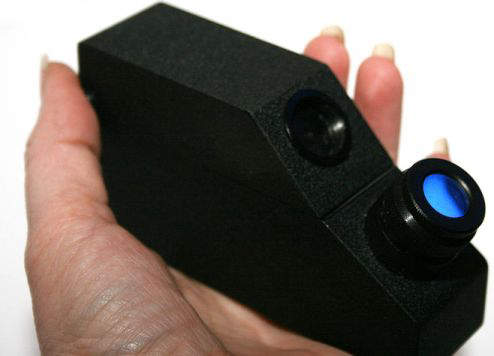
Portable Refractometer for testing gemstones
Photo:By Michelle, C.C
Specially designed refractometers for testing gemstones as seen above is a portable instrument which should be used with a good light source. It is a very important gem testing instrument as most gemstones can be identified by it.
Unfortunately the refractometer cannot be used for rough gemstones.
Gemstones can be either singly refractive (Isotropic-One reading or one refractive index eg Spinel- 1.718) or double refractive (Anisotropic-Two readings or two refractive indices eg Corundum sapphires & Rubies 1.764- 1.772).
The difference between the two refractive indices is known as the birefringence, in sapphires birefringence= 0.008
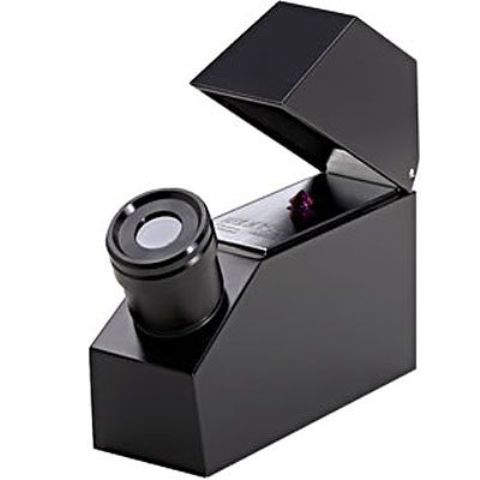
Kruess Professional Gemstone Refractometer with LED monochromatic light source.
The Kruess professional gemstone refractometer comes with an LED monochromatic light source and automatic voltage switching between 90 to 240 volts. A polarizing filter and an eyepiece magnifier are suppliedwith it.
Uses of Refractometer:
The refractometer can be used to determine the refractive index. One can also use the refractometer to determine if a gemstone is singly refractive or double refractive. The birefringence (The difference between the two refractive indices in double refractive gemstones) can also be calcuated.
The Optic Character of a gemstone (Uniaxial or Biaxial), the direction of the optic axis, optic sign (Positive or negative) and the approximate refractive index on curved surfaces can also be determined using a refractometer.
Brief description of how to use a refractometer
Clean the gemstone. A drop of contact liquid should be put on the glass prism. Too much of contact liquid can cause a dark ring around the stone which will confuse the reading.
Slide the stone into contact with the liquid gently, with your fingers. Do not use tweezers. The largest well polished facet should be used in faceted gemstones. For cabochons the best polished area should be used.
The image of the stone should be observed under white/ monochromatic light. The stone will appear as a black spot having the shape of the contact facet.
Cabochons gemstones, small facets, curved surfaces and for poorly polished facets the reading should be taken where the spot is exactly half light and half dark, the spot blinks from dark to light or the spot lightens gradually the reading should be taken where the spot becomes a completely light spot. In cabochon gems with high birefringence the refracive indices of the gemstone can be obtained by using the birefringence blink method. In this method the poloroid filter is placed over the eye piece while observing the spot over the eye piece and the reaction of the spot is noted. The spot will blink from lght to dark or from red to green. The spot where the light starts blinking is read on the scale and the point where it stops blinking is also read on the scale. The difference between these two readings is calculated and the difference will give the birefringence.
In faceted gemstones the precise refractive index of the contact facet will appear as a sharp black/grey line or cut off. Then the poloroid filter should be placed over the eye piece and rotated. If the grey/black line or cut off remains constant then the stone is singly refractive (S.R). However if on rotating the poloroid filter the grey/black line moves up or down then the stone id double refractive (D.R) and the birefringence would have to be determined. To determine the birefringence of the faceted gemstone the poloroid filter should be rotated and any shift in the shadow noted. While rotatating the stone the readings should be taken from at least 4 different directions. The difference between the maximum and minimum reading will give the birefringence of the gemstone.
A R.I greater than 1.8 cannot be tested on most refractometers. Over range stones will show a grey cut off reading or spectral colors at 1.80. A spot reading of an over range stone will change completely white at 1.80.
The readings of the stone should be taken before evaporation of the liquid. The evaporation of the liquid can change the refractive index by changing the higher limit of the refractometer.
After the readings are taken the stone should be gently taken from the glass prism.
Taking care of your refractometer
The hardness of the glass prism is much lower than the hardness of most gemstones that will tested on the refractometer. Therefore the glass prism will scratch very easily. One should be very cautious when placing or removing the stone from the glass prism. Never use tweezers when placing the stone on the glass prism. Special care should be taken when placing mounted stones for testing as the metal can scratch the prism.
If the refractometer is not going to be used for a long time, place a thin film of vaslene on the surface of the glass prism so as to prevent tarnishing.
Sulphur crystals form when the contact liquid evaporates. therefore when you wipe the glass with a dry cloth the sulphur crystals can scratch the glass prism. Therefore the crystals should be removed first with more contact liquid and the glass should be wiped gently.
Disadvantages of the Refractometer:
i) Rough gemstones cannot be tested by using a refractometer.
ii) Most refractometers available are the critical angle refractometers.
iii)Gemstones with a refractive index of >1.8 cannot be tested on a refractometer.
However a new generation refractomer called the Brewster angle refractometer can measure a much wider range from 1.4 to 3.5. An added advantage of this model is that it does not require contact liquid.
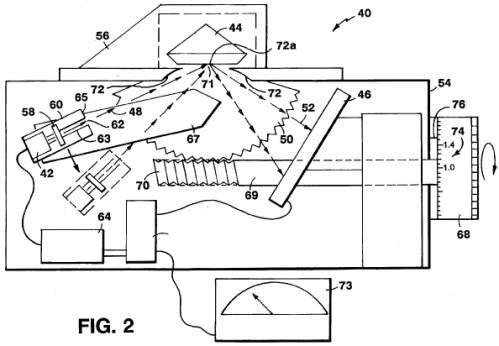
The Brewster Wide Range (1.4 to 3.5) Refractometer
The Brewster angle refractometer is based on the principle that the reflectivity of light polarized parallel to the plane of incidence is minimized at the brewster angle and can be used to determine the refractive index of a material. The refractometer is equipped with a precision mechanical drive arrangement for precisely determining the refractive index over a range of 1.4 to 3.0. It has an accuracy of at least 0.02
The following photographs of laboratory refractometers is for educational purpose only. These refractometers are not routinely used in gemmology, but can measure refractive index of liquids and solids, with applications in medicine, agriculture, applied chemistry etc.

Traditional Abbe Refractometer
User obtains readings by lining up crosshairs and reading graduations in the view. Note the external thermometer and the ports for circulating water.
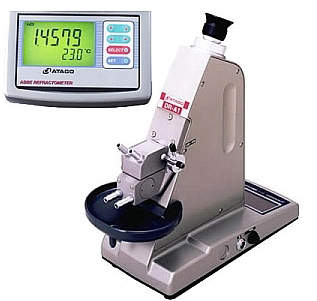
Digital Display Abbe Refractometer
User still has to line up crosshairs in the eyepiece but the reading is displayed on the digital readout. Thermometer is now internal but waterbath is still required for accurate measurements.

Multi- Wavelength Abbe Refractometer
Operates on the same principales as Digital Display Abbe, but fitted with additional components with which to measure at different wavelengths. Also calculates Abbe number automatically. Waterbath still necessary for accuracy.

Modern Digital Laboratory Refractometer
Circulating water is no longer required for temperature control. The ‘crosshair’ display is also replaced by push buttons. The accuracy of the instrument is increased to 5th or sometime the 6th decimal place of refractive index. Can be linked to a printer for hard copy or computer for remote operation.
The Refractometry method of measurement of Refractive Index
Here immersion methods are used to determine the refractive index of the gemstone.
The commonly used methods are:
i) Becke Line Method:
The refractive index of faceted gemstones can be determined using this method.
A microscope with light field illumination is used in this method.
The gemstone should be placed in an immersion cell with the table facet down.The refractive index of the immersion liquid should be known.The transmitted light to the area of the stone may be adjusted using the aperture below.
Initially the focus of the microscope should be in the liquid above the stone. If the edges of the facets appear black and change to white when the focus is lowered into the stone, the liquid has a higher refractive index. If the refractive index of the stone is higher the revere would occur.
Therefore by using liquids of different index, the refractive index of the stone can be determined.
ii) The Minimum Deviation Method:
This is probably the most accurate method of measuring the refractive index. However this method requires a table spectrometer, which is also known as a goniometer.
iii) The Direct Measurement Method:
This method requires a microscope with a calibrated focus adjustment.
This method requires that the stone have two parallel facets (eg the Table and culet).
The table facet should be focussed first and the reading taken (Reading A), then focus on the culet till it is sharply defined (Reading B).The glass slide on which the culet rests should be focused (Reading C).
Now the real depth (C-A) and apparent depth (B-A) can be calculated.
The refractive index of the gemstone can be calculated by dividing the real depth by the apparent depth. ie RI= real depth ÷ apparent depth.
iv) Immersion Contrast Method:
In this method the appearance and disappearance of the girdle and edges of the facet is observed, when immersed in a liquid of known refractive index.You are welcome to discuss this post/related topics with Dr Shihaan and other experts from around the world in our FORUMS (forums.internetstones.com)


Thank you for information